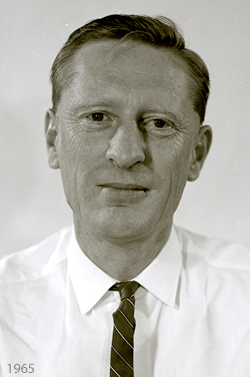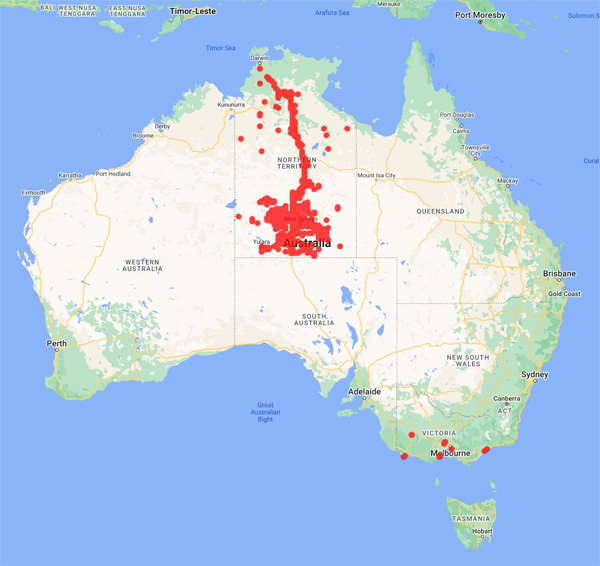
Council of Heads of Australasian Herbaria
Australian National Herbarium
Biographical Notes
 |
Council of Heads of Australasian Herbaria |
 Winkworth, Robert Ernest (Bob or 'Winky') (1927 - 2003)
Winkworth, Robert Ernest (Bob or 'Winky') (1927 - 2003)Born: 19 November, 1927 at Summer Hill, Sydney, NSW; died 22 June 2003, at Haberfield, Sydney, aged 75.
Bob Winkworth was a graduate of the University of Sydney, and worked in the Botany Department of the University of Melbourne as a demonstrator while he undertook Honours in 1953. At that time he married Dylis Mary Hurst, his first wife.
Bob became the first CSIRO resident scientist in Alice Springs, arriving at the end of 1953. His house at 6 Renner Street, in the Eastside of Alice Springs, was the first CSIRO facility, and a World War II shed in his yard functioned as the field station. Once the Arid Zone Unit was established in 1954, a house at 12 Gregory Terrace in the central town area was purchased to serve as a base, becoming CSIRO's Alice Springs Field Centre.
He was the sole representative of the Arid Zone Unit on its establishment in 1954. The role of the unit was to investigate native plant communities under conditions of grazing "so that their full utilisation can be achieved without causing deterioration" and to investigate "the use of exotic crop, pasture and tree species, either to replace native communities under condition of natural rainfall, to reclaim degenerate land or more efficiently utilise specially favoured localities".
During 1954-5, Winkworth, an expert plant taxonomist, joined a survey team led by Ray Perry that was working along 24,000 km of transects to investigate the plant ecology of central Australia, in preparation for future vegetation mapping. Formal description and mapping of the lands of the Alice Springs area was undertaken 1956-7 by a team of Land Research and Regional Survey scientists including Ray Perry (ecologist), and Mike Lazarides (botanist). The resultant report underpinned a great deal of subsequent research in central Australia.
Winkworth also began investigating the potential for range reseeding in collaboration with the Northern Territory Administration, collecting seed from native species as well as naturalised strains of buffel grass (Cenchrus ciliaris), and establishing a plant nursery on the Animal Industry Branch farm (which became the Arid Zone Research Institute from 1967). At this time he worked closely with George Chippendale who headed the Herbarium at Alice Springs.
In 1964, Winkworth left Alice Springs and was sent to Iraq with UNESCO and, when he returned, was based in Canberra, and by 1972 was living at 13 Boucaut Pl. Curtin. At this time he worked on plant-water relations and had field sites in central Australia and on the Barkly Tableland.
He returned briefly to Alice Springs as Acting Officer-in-Charge of the Rangeland Research Programme in 1975.
In later years he travelled widely, following his interest in the historic distribution of buffel grass, and collecting records of current distribution, photos of camel harness, buffel varieties etc, and talking with numerous people. His aim was to write a book or a monograph on buffel grass but he died before it could be done.
He continued to engage with science in other ways too, attending conferences and debating issues enthusiastically! On his last visit to Alice, he gave away some of his treasures – his daughter Sandra's (very competent) sketches of plants plus some books – and gave a slide show of his time in Iraq.
He died in Sydney in 2003 where where he was living in retirement with his daughter at Haberfield.
Sources:
Extracted from:
Margaret H. Friedel and Stephen R. Morton
'A history of CSIRO's Central Australian Laboratory, 1: 1953-80: pastoral land research'
Historical Records of Australian Science, CSIRO Publishing (2023)
https://doi.org/10.1071/HR22006
Margaret Friedel (2023) pers. com.
Death notice, Sydney Morning Herald 25/6/2003
Portrait Photo: from https://doi.org/10.1071/HR22006
Data from 1,999 specimens
